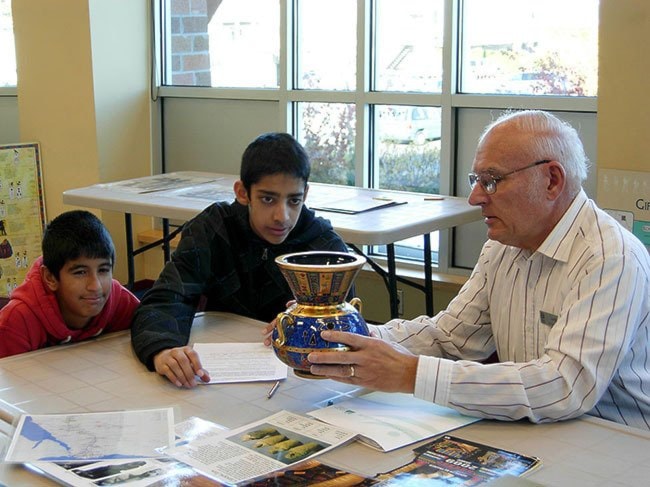Every time she welcomes a new school group to the Surrey Long Ago program at the Surrey Museum, Diane Radcliffe asks how many of them would like to be a pioneer child.
“There’s always one kid that puts up their hand,” she says, suggesting if they really knew what it was like, no hands would be going up.
Radcliffe is a volunteer with Surrey Long Ago, a school program for primary students to Grade 3 that explores what life was like growing up in Surrey in the late 19th and early 20th century.
The kids visit a real, 1870s log cabin that was built by Surrey pioneer Eric Anderson, and also attend an historical classroom lesson.
“I think it’s an eye-opener for them,” says Radcliffe, a Cloverdale resident who has volunteered with the same school program for many years.
“I go through the litany of things they would have done as a pioneer child. First off, they’d have to walk to school – there was nobody driving them.”
 They also had to walk to school – sometimes as far as a kilometer, she notes drily – and some of the children didn’t even have any shoes because shoes were expensive.
They also had to walk to school – sometimes as far as a kilometer, she notes drily – and some of the children didn’t even have any shoes because shoes were expensive.
“You wouldn’t have wanted to be a pioneer child,” she insists firmly. “Or a pioneer teacher. For one, you couldn’t get married.”
[IMAGE 192.03 COURTESY
SURREY ARCHIVES
A school group poses outside Cloverdale School, circa 1890.]
She also talks about how corporal punishment was meted out to pioneer-era students who misbehaved.
“We also talk about how the girls had to wear pinafores, and no, they didn’t shower and bathe every day.”
In Surrey’s early days, most students were less removed from rural life and were familiar with hardships and deprivations that are simply astounding to today’s students.
Still, the pioneer era had its charms. The log cabin, says Radcliffe, is always a big hit with students.
“The kids love the cabin.”
Surrey Long Ago is one of three school programs needing new volunteers for fall.
People of the Land explores West Coast First Nations traditions. Students learn about resource gathering and other topics, and try their hand at cedar weaving and sample a traditional feast of salmon and berries.
Ancient Buried Treasures is for Grades 6-7. Students do a simulated archeological dig, and examine reproductions of ancient Egyptian and Greek objects.
Other long-time volunteers include people like Gary Goebel, a history buff and school program docent, and Roger Bose, who frequently leads public tours and walks.
The Surrey Museum’s school programs start on Oct. 2, and are offered on Tuesdays Wednesdays and Thursdays.
There’s a volunteer orientation session on Sept. 12 for those interested in finding out more.
The positions are ideal for retired people and parents with school-age children.
Volunteers don’t need any special qualities or expertise, says Radcliffe. “I think they just need to be able to enjoy children.”
She began volunteered at her children’s schools when they were growing up and when her youngest daughter graduated from high school, Radcliffe decided to look into volunteering with the Surrey Museum’s school programs after hearing about them through an acquaintance.
“It’s a great program to do.”
When they’re learning the ropes, volunteers receive a sheet containing all the material they need to know.
It’s not hard learning the material, and new volunteers receive lots of help from the veterans. Newbies are allowed to shadow someone until they’re comfortable working with student groups alone.
“It’s not hard,” she says.
Volunteers don’t wear costumes, she points out. They rotate through the various stations, delivering information. Radcliffe uses cards. Others “wing it,” she says.
The curriculum-based programs are set up for elementary students from Grades 1 to 7 and are used by classes from across Surrey, Delta, Langley, and New Westminster, along with private schools. Several of the most popular programs have been adapted for home schoolers.
In Surrey Long Ago, students are guided through a series of stations in parts of the Surrey Museum’s permanent gallery, then outside to the cabin.
“We each have a group and take them to different stations,” she explains, adding, “After a while, you get into a rhythm and it just becomes natural.”
They also look at artifacts that would have used at home and work.
Every group is different, she says.
“There’s a lot of information that we give out. We try to make it fun.”
Passing along Surrey’s history to a new generation has also taught her to appreciate living in an era of modern labour-saving devices, technological advances, and enlightened attitudes.
“When I see what the pioneer women, how hard they worked, and how long they worked, even though I sometimes complain at home... to get the community going, it wasn’t easy. They didn’t have the roads. They didn’t have the cars. We just don’t appreciate what we have, really.”
Recalling a day when up to 10 neighbouring homes shared one telephone party line, she wonders, “How did I live in that environment?”
It was, she says, a simpler time.
“I think we have it easier in many ways, but I’m glad when my kids were growing up, we didn’t have things like Facebook.”
For more information, call 604-502-6461 or visit www.surrey.ca/heritageschool.
